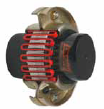The next information and facts is critical when generating a Grid coupling variety:
Description of motor or engine, the horse power (or KW), and RPM at slowest coupling speed while underneath load
Description in the driven products
Shaft and keyway sizes along with the kind of match for driver and driven equipment (clearance or interference)**
Shaft separation (BSE)
Physical room limitations (see Application Worksheet)
Determine what the environmental circumstances is going to be, this kind of as temperature, corrosive circumstances, interference from surrounding structures, and so forth.
By default, sizes 1020 – 1090 might be clearance fit, sizes 1100 – 1200 is going to be interference match. 
** Machines all bores and keyways to meet the dimensional and tolerance specifications per ANSI/AGMA 9002-B04 for inch bores, or ISO 286-2 for metric bores.
Normal grid couplings consist of two grid hubs, a grid spring, in addition to a cover assembly. Once the shaft separation needs a spacer type coupling, the coupling will consist of two shaft hubs, two spacer hubs, a grid spring, and a horizontal cover assembly.
Formulas Employed To Calculate Torque:
Application Torque (in-lbs) = ( horse electrical power x 63025 ) /RPM
Application Torque (Nm) = ( horse power x 9550 ) /RPM
Variety Torque = Application Torque x Services Element
Large Peak Loads and Brake Applications
For applications wherever higher peak loads or large braking torques could be current, the following supplemental data is going to be essential:
Technique peak torque and frequency
Duty cycle
Brake torque rating
The variety torque formula is just like the formula proven above except that the application torque needs to be doubled before applying the services component.
Application Torque (in-lbs) = ( horse power x 63025 ) /RPM
Application Torque (Nm) = ( horse power x 9550 ) /RPM
Assortment Torque = 2 x Application Torque x Service Aspect
Measures In Picking A Grid Coupling
Step one: Determine the application torque applying the formula proven above.
Stage two: Choose the Services Issue from your charts .
For applications not displayed use the chart shown to your ideal. Establish the Variety Torque applying the formula shown over.
Stage three: Utilizing the variety torque as calculated, refer towards the Efficiency Chart
Stage four: Evaluate the utmost bore to the dimension picked and assure the demanded bore sizes don’t exceed the utmost allowable. If your expected bore dimension is bigger, step as much as the subsequent dimension coupling and check out to see when the bore sizes will match.
Stage 5: Making use of the chosen coupling dimension, evaluate the bore and keyway sizes
Stage six: Get hold of your neighborhood industrial supplier using the portion numbers to location sizes with all the charts for UPC component numbers.